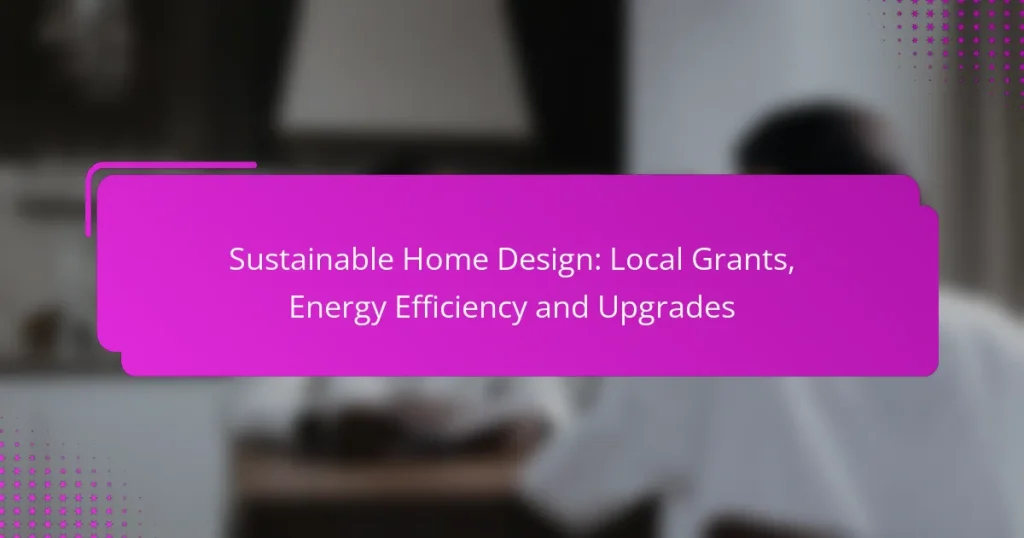Investing in sustainable home design not only benefits the environment but also offers financial incentives through local grants aimed at reducing the costs of energy-efficient upgrades. By focusing on key areas such as insulation, windows, and smart technology, homeowners can enhance their comfort and significantly lower energy bills. Embracing these upgrades not only increases property value but also contributes to a more sustainable future.
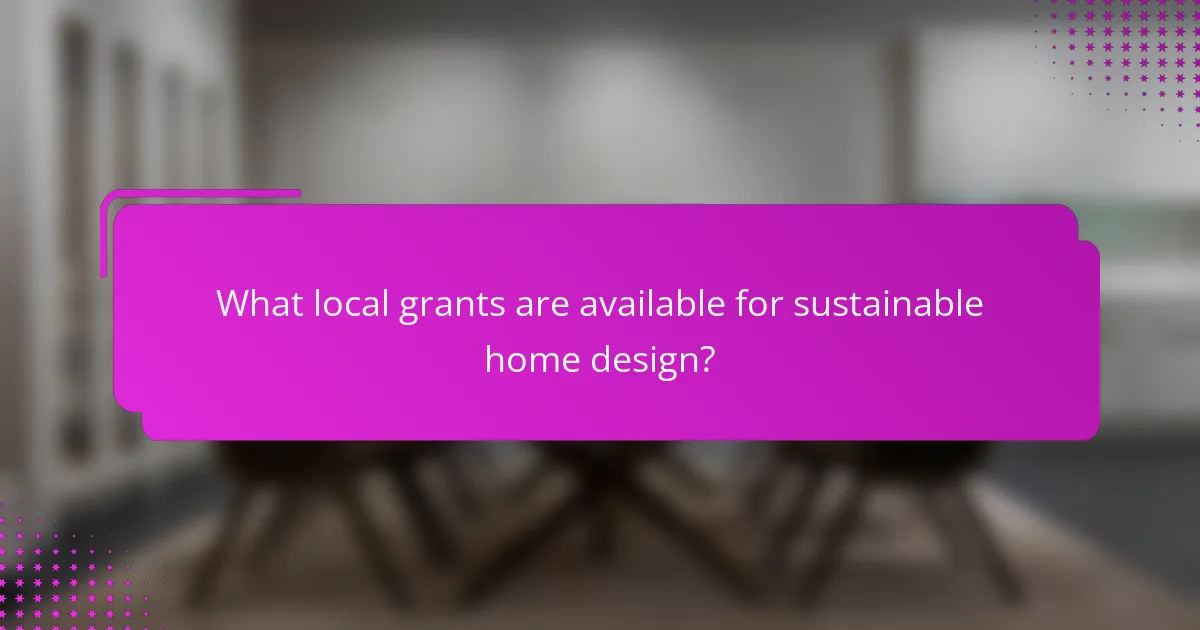
What local grants are available for sustainable home design?
Local grants for sustainable home design can significantly reduce the costs associated with energy-efficient upgrades and eco-friendly renovations. These grants are often provided by state agencies, federal programs, and local governments to encourage homeowners to invest in sustainable practices.
California Energy Commission grants
The California Energy Commission (CEC) offers various grants aimed at promoting energy efficiency and renewable energy projects. Homeowners can apply for funding to support upgrades such as solar panel installations, energy-efficient appliances, and insulation improvements.
To qualify, applicants typically need to demonstrate how their projects will reduce energy consumption or greenhouse gas emissions. It’s advisable to check the CEC’s website for specific eligibility criteria and application deadlines.
Federal Housing Administration programs
The Federal Housing Administration (FHA) provides programs that facilitate financing for energy-efficient home improvements. One notable option is the Energy Efficient Mortgage (EEM), which allows borrowers to finance energy-saving upgrades as part of their home loan.
Homeowners interested in this program should consult with FHA-approved lenders to understand the application process and potential benefits. This can be a valuable resource for those looking to make significant energy-efficient renovations without upfront costs.
State-specific energy efficiency incentives
Many states offer their own energy efficiency incentives, which can include grants, rebates, and tax credits for sustainable home improvements. These incentives vary widely, so it’s essential to research what is available in your specific state.
Homeowners should visit their state energy office’s website to find detailed information on available programs, eligibility requirements, and application procedures. Engaging with local utility companies can also reveal additional incentives for energy-efficient upgrades.
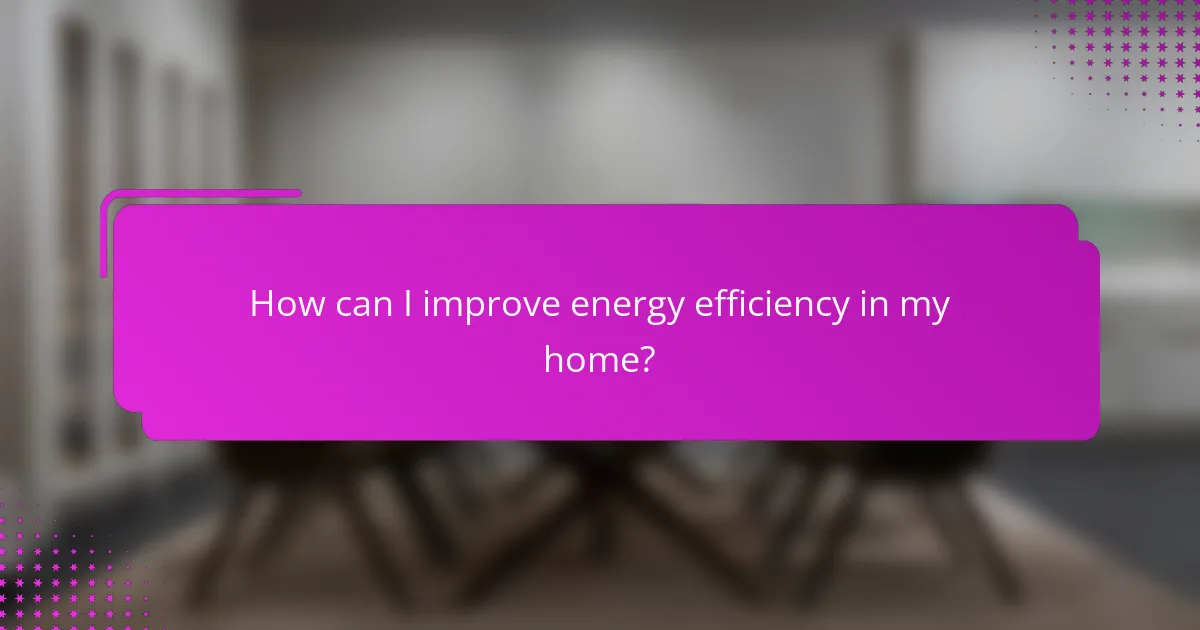
How can I improve energy efficiency in my home?
Improving energy efficiency in your home involves making upgrades that reduce energy consumption and enhance comfort. Key areas to focus on include insulation, windows, and smart technology, which can collectively lead to significant savings on energy bills.
Insulation upgrades
Upgrading insulation is one of the most effective ways to enhance energy efficiency. Proper insulation in walls, attics, and basements helps maintain a consistent indoor temperature, reducing the need for heating and cooling systems.
Consider materials like fiberglass, foam board, or spray foam, which can provide varying levels of thermal resistance (R-value). For example, an R-value of 30-60 is often recommended for attics in colder climates.
When upgrading insulation, ensure it meets local building codes and consider hiring a professional for installation to avoid common pitfalls like air leaks.
Energy-efficient windows
Energy-efficient windows can significantly lower heating and cooling costs by minimizing heat transfer. Look for windows with double or triple glazing and low-emissivity (Low-E) coatings that reflect heat while allowing light in.
When selecting windows, consider the U-factor (which measures heat transfer) and the Solar Heat Gain Coefficient (SHGC). Aim for U-factors below 0.30 for optimal performance.
Replacing old windows can be a larger investment, but it often pays off in energy savings and increased home value over time.
Smart home technology
Smart home technology can optimize energy use by allowing you to control heating, cooling, and lighting remotely. Smart thermostats, for instance, can learn your schedule and adjust temperatures accordingly, potentially saving 10-15% on heating and cooling costs.
Consider integrating smart lighting systems that can be programmed or controlled via smartphone apps to reduce energy consumption when rooms are unoccupied.
Investing in smart technology not only improves energy efficiency but also enhances convenience and can increase your home’s appeal to future buyers.

What are the benefits of sustainable home upgrades?
Sustainable home upgrades offer numerous advantages, including cost savings, enhanced property value, and a positive impact on the environment. By investing in energy-efficient solutions, homeowners can enjoy lower utility bills while contributing to a more sustainable future.
Lower utility bills
One of the most immediate benefits of sustainable home upgrades is the reduction in utility bills. Energy-efficient appliances, improved insulation, and solar panels can significantly decrease monthly energy costs. Homeowners can often save anywhere from 20% to 50% on their energy expenses, depending on the upgrades made.
To maximize savings, consider conducting an energy audit to identify areas for improvement. Simple upgrades like sealing drafts and installing programmable thermostats can yield quick returns on investment.
Increased property value
Sustainable upgrades can enhance a home’s market value, making it more attractive to potential buyers. Homes equipped with energy-efficient features often sell for higher prices compared to traditional homes. Studies suggest that properties with green certifications can command premiums of 5% to 15% over similar homes without such features.
When planning upgrades, focus on high-impact improvements like energy-efficient windows, modern HVAC systems, and sustainable landscaping. These enhancements not only boost value but also appeal to eco-conscious buyers.
Environmental impact reduction
Upgrading to sustainable home features significantly reduces a household’s environmental footprint. By using less energy and water, homeowners contribute to lower greenhouse gas emissions and resource conservation. For instance, switching to LED lighting and high-efficiency appliances can cut energy consumption by up to 75% compared to traditional options.
In addition to personal benefits, these upgrades support broader environmental goals. Homeowners can participate in local sustainability initiatives and may qualify for grants or incentives aimed at promoting energy efficiency and renewable energy use.
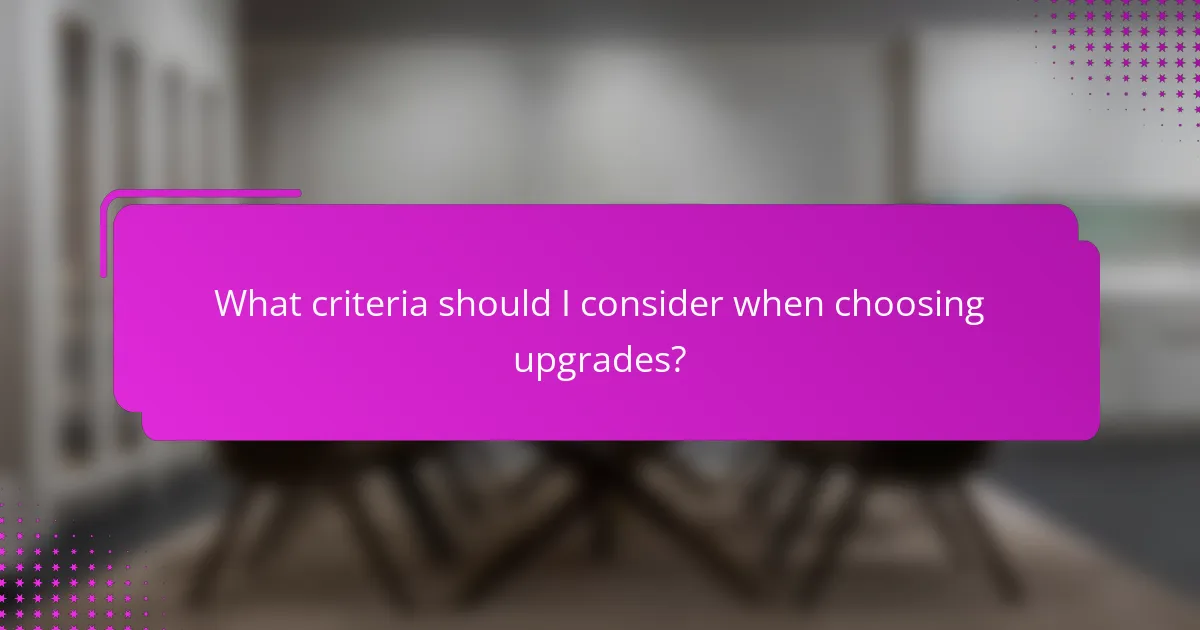
What criteria should I consider when choosing upgrades?
When selecting upgrades for sustainable home design, consider factors such as cost-effectiveness, energy savings, and local climate suitability. Prioritizing these criteria will help ensure that your investments yield long-term benefits and align with your environmental goals.
Cost vs. savings analysis
Conducting a cost versus savings analysis is essential to determine the financial viability of upgrades. Start by estimating the upfront costs of each upgrade and compare them to potential savings on energy bills over time. For example, energy-efficient windows may have a higher initial cost but can lead to significant savings on heating and cooling expenses.
To make informed decisions, consider using a simple formula: divide the total cost of the upgrade by the annual savings to find the payback period. A payback period of less than five years is generally considered a good investment. Additionally, look for local incentives or rebates that can further reduce upfront costs.
Local climate considerations
Local climate plays a crucial role in determining which upgrades will be most effective for your home. For instance, homes in colder regions may benefit more from enhanced insulation and energy-efficient heating systems, while those in warmer climates might prioritize cooling solutions and reflective roofing materials. Understanding your area’s climate patterns can guide your upgrade choices.
Research local weather trends and energy efficiency guidelines to select upgrades that align with your environment. For example, in regions with high humidity, consider dehumidifiers or ventilation systems to improve indoor air quality. Tailoring your upgrades to local conditions will maximize their effectiveness and comfort in your home.
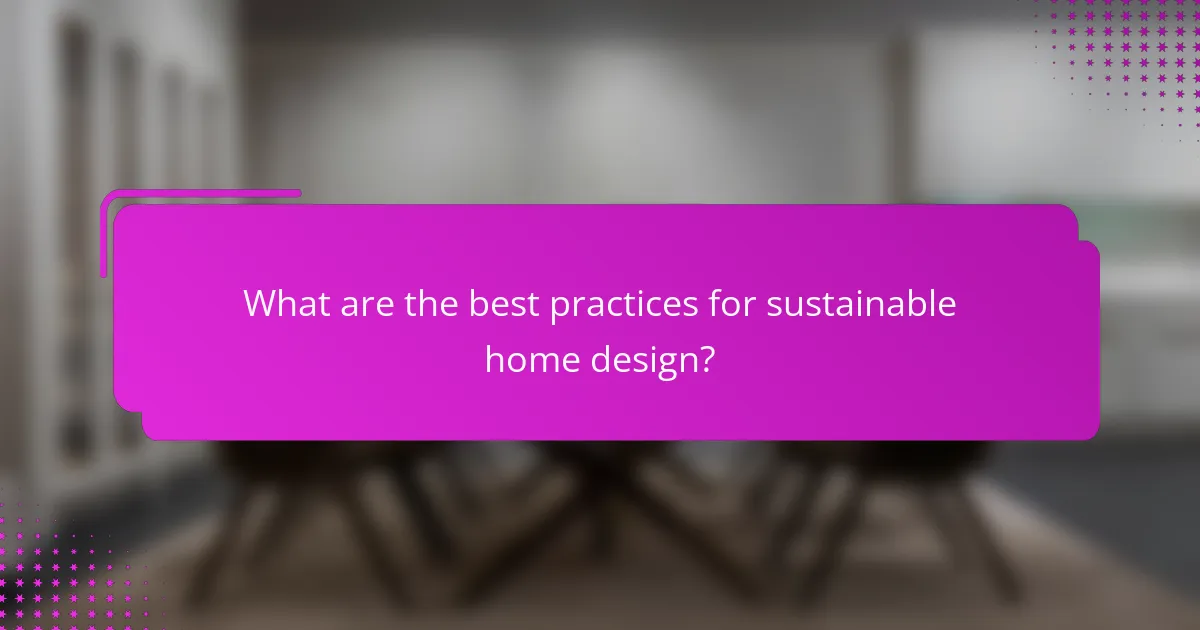
What are the best practices for sustainable home design?
The best practices for sustainable home design focus on minimizing environmental impact while maximizing energy efficiency and comfort. Key strategies include using renewable materials, incorporating passive solar design, and optimizing energy systems.
Use of renewable materials
Using renewable materials in home design involves selecting resources that are sustainably sourced and have a lower environmental footprint. Common options include bamboo, reclaimed wood, and recycled metal. These materials not only reduce waste but also often require less energy to produce compared to traditional materials.
When choosing renewable materials, consider their durability and maintenance needs. For example, bamboo flooring is both sustainable and resilient, making it a practical choice for many homeowners. Always verify certifications, such as FSC (Forest Stewardship Council), to ensure responsible sourcing.
Incorporating passive solar design
Passive solar design harnesses natural sunlight to heat and light a home, reducing reliance on artificial energy sources. Key elements include strategic window placement, thermal mass materials, and overhangs that block excessive summer sun while allowing winter sunlight to warm interiors.
To effectively implement passive solar design, assess your site’s orientation and climate. For instance, homes in colder regions benefit from larger south-facing windows, while those in warmer climates may need smaller openings to minimize heat gain. Regularly check local building codes to ensure compliance with any regulations regarding energy efficiency.
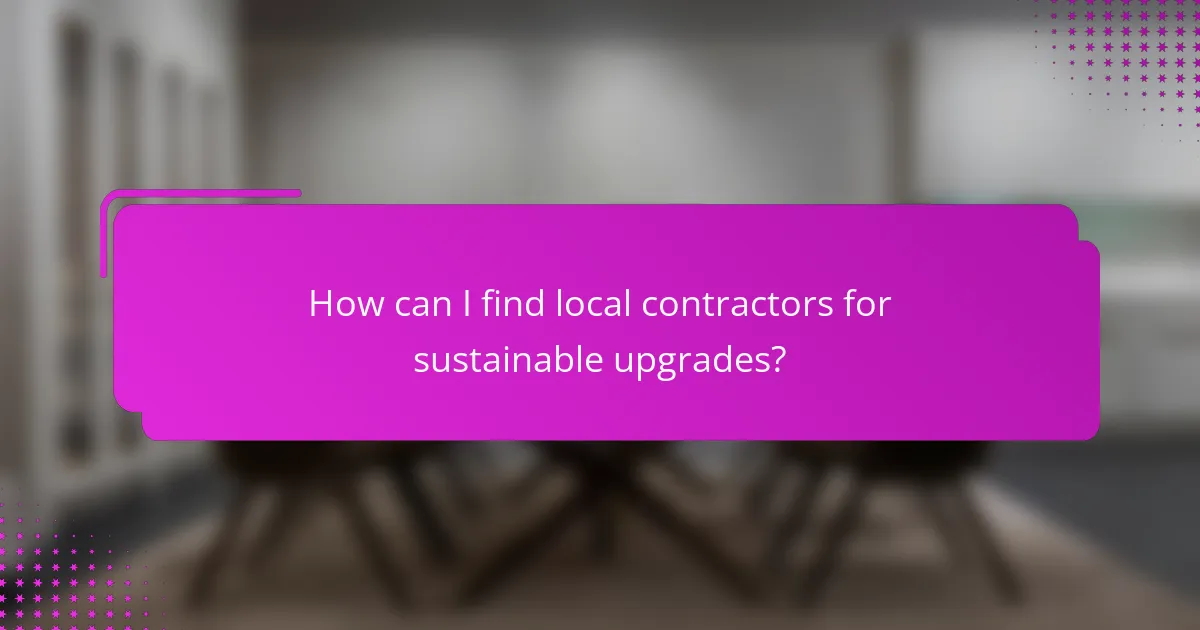
How can I find local contractors for sustainable upgrades?
To find local contractors for sustainable upgrades, start by researching professionals who specialize in energy-efficient renovations and eco-friendly materials. Utilize online directories, community boards, and local sustainability organizations to identify qualified experts in your area.
Utilize online resources
Websites like Angie’s List, HomeAdvisor, and Thumbtack can help you find contractors who focus on sustainable home improvements. These platforms often include customer reviews and ratings, which can give you insight into the contractor’s reliability and expertise in green building practices.
Additionally, check local government websites for lists of certified contractors who meet specific energy efficiency standards. Many municipalities offer resources for homeowners looking to make eco-friendly upgrades.
Ask for recommendations
Word-of-mouth referrals can be invaluable when searching for reliable contractors. Speak with friends, family, or neighbors who have undertaken similar sustainable projects to get their recommendations. This can lead you to trustworthy professionals who have proven experience in energy-efficient upgrades.
Consider reaching out to local environmental groups or community organizations, as they may have connections to contractors who prioritize sustainability in their work.
Check credentials and experience
Once you have a list of potential contractors, verify their credentials. Look for certifications such as LEED (Leadership in Energy and Environmental Design) or Energy Star ratings, which indicate a commitment to sustainable practices. Experience with local building codes and regulations is also essential.
Request examples of past projects and references to assess their expertise in sustainable upgrades. This will help ensure that you choose a contractor who can effectively meet your specific needs and expectations.
